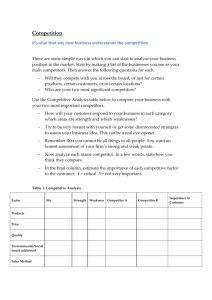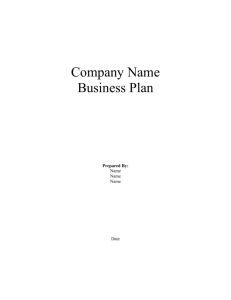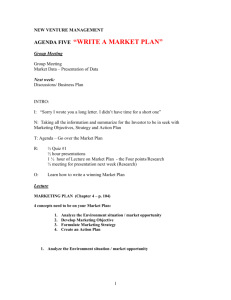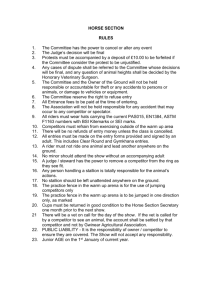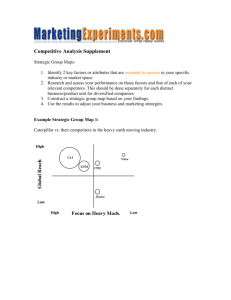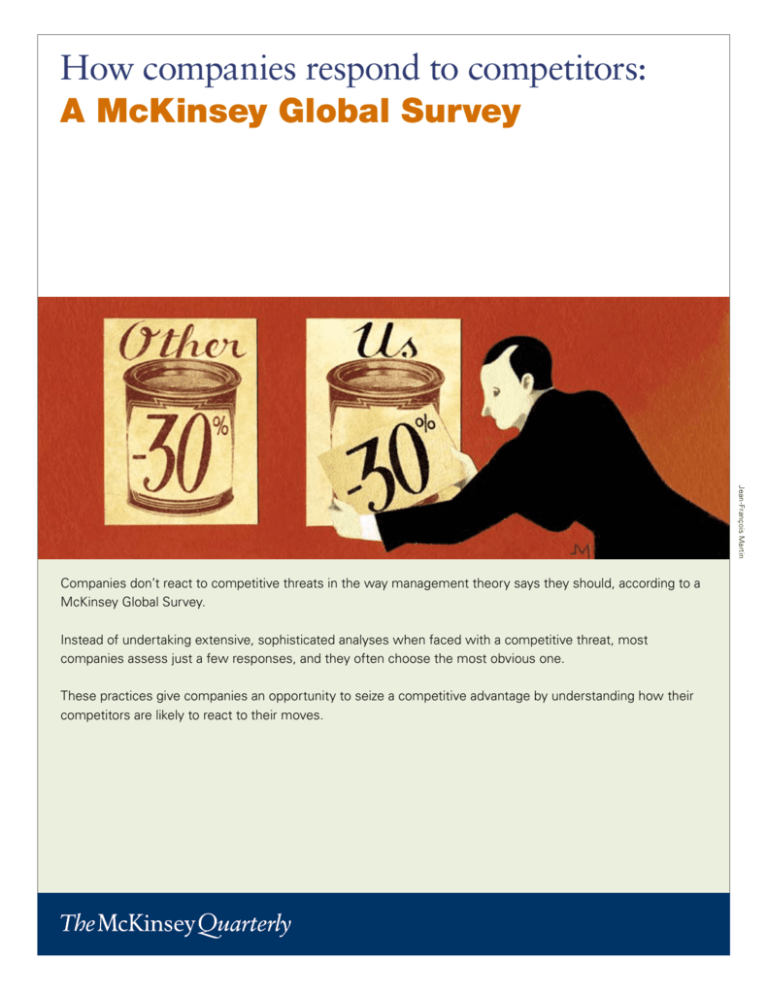
How companies respond to competitors:
A McKinsey Global Survey
Jean-François Martin
Companies don’t react to competitive threats in the way management theory says they should, according to a
McKinsey Global Survey.
Instead of undertaking extensive, sophisticated analyses when faced with a competitive threat, most
companies assess just a few responses, and they often choose the most obvious one.
These practices give companies an opportunity to seize a competitive advantage by understanding how their
competitors are likely to react to their moves.
2
How companies respond to competitors: A McKinsey
Global Survey
Management theory suggests that companies facing serious competitive threats
should extensively analyze how to fight back. Actual managers, however, say they are
satisfied with the results of a less active approach, according to a McKinsey survey.
Companies that understand how their competitors really react may be able to
gain an edge.
When a competitor strikes—introducing
an innovative new product, for example, or
slashing prices—management theory suggests
that companies should immediately dive into
complex analyses of their possible moves and
countermoves across the whole competitive
landscape, assess these potential responses
with sophisticated financial metrics such as net
present value (NPV), and promptly mount a
response.
The real world is much simpler, according to a
McKinsey survey of executives from around the
world and from a variety of sectors, including
financial services, manufacturing, and high
tech.1 On the whole, as companies determine
how to respond to a competitor’s moves, they
generally assess three or fewer options and don’t
look forward more than two years. About
half don’t examine more than one round of
countermoves by any competitor. A significant
number rely on intuition to determine a
response. And companies most frequently
respond with whatever counteraction is most
obvious in the moment—answering a price cut,
for example, with a cut of their own, which
often doesn’t hit the market until at least one or
two sales cycles after the competitor’s move.
Even so, most respondents to the survey say
they were able to counteract at least some of the
reduction in earnings they expected when
they found themselves facing a competitor’s
price change or innovation. Overall, they say
they expected earnings to fall by an average
of 7 percent, and only 22 percent of respondents
felt they could offset at most 25 percent of the
expected decline.2 In addition, a majority
would conduct their analysis the same way—or
even less exhaustively—if they faced the same
situation again.
Knowing that responses to competitive moves
are generally straightforward and relatively
slow—and that companies are unlikely to
change in this respect—gives managers new
ways to think about how they might gain
competitive advantage from their own moves.
1
The McKinsey Quarterly conducted the survey in April 2008 and received 1,825 responses from a worldwide representative sample of business executives.
Half (914) responded to questions about major innovations by a competitor, and the other half (911) to questions about pricing changes. All data are weighted by
the GDP of the constituent countries to adjust for differences in response rates.
2
These figures exclude respondents who answered “don’t know” to either question.
Source: April 2008 McKinsey Quarterly survey on competitive behavior
3
Monitoring the competitive landscape
This survey asked executives how their
companies responded to a specific competitive
situation: either a significant price change or a
significant innovation. Answers about both
were strikingly similar in most cases, as were
the answers of executives across regions and
industries.
an innovation and 44 percent of those
facing a pricing change say they found out about
the competitor’s move either when it was
announced or when it actually hit the market.
An additional 20 percent of the respondents
facing a pricing change didn’t find out until it had
been in the marketplace for at least one or two
reporting cycles.
A majority of executives in both groups say their
companies found out about the competitive
move too late to respond before it hit the market
(Exhibit 1). Thirty-four percent of those facing
Survey 2008
Competitive behavior
Exhibit 1 of 6
Glance:
Exhibit title: A late response
Exhibit 1
A late response
% of respondents1
Relative to when this major competitive move hit the market, when did you learn about it?
Innovation
Long enough before innovation or pricing change
was announced to be able to plan response
before it hit market
23
Before innovation or pricing change was
announced but too late to plan response before it
hit market
9
Shortly after innovation or pricing change
hit market
9
who answered “don’t know” are not shown.
Source: April 2008 McKinsey Quarterly survey on competitive behavior
16
25
At the time innovation or pricing change
hit market
1Respondents
12
24
At the time innovation or pricing change
was announced
Only after innovation or pricing change had been
in market long enough to affect our company’s
performance
Pricing change
4
20
24
16
4
4
These findings suggest that companies aren’t
conducting an ongoing, sophisticated analysis of
their competitors’ potential actions. That view
is supported by the executives’ responses to
questions on how they gather information about
what competitors might do. Executives most
often say they track information from news
reports, industry groups, annual reports, market
share data, and pricing data (Exhibit 2). Far
fewer respondents obtain information from
more complex sources, such as the reverse
engineering of products or mystery shopping.
Yet the threat is real. Respondents say the
competitive move they were answering
questions about had the potential to cause a
noticeable reduction in their annual earnings—
an average of 7 percent. Among those who
answered the questions about innovation,
50 percent say they expected a drop of 6 percent
or more, and 9 percent a drop of 21 percent
or more. Among respondents facing a price
change, 45 percent expected a drop of 6 percent
or more, and 6 percent a drop of 21 percent
or more.3
Survey 2008
Competitive behavior
Exhibit 2 of 6
Glance:
Exhibit title: Tracking competitors
Exhibit 2
Tracking competitors
% of respondents1
What kinds of information do you typically
gather about competitors?
News reports
63
Information or analysis from industry
groups or conferences
63
Annual reports, including financialperformance data
64
63
Pricing data
63
63
56
53
Analyst reports
51
48
Speeches by competitors’ leaders
Direct consumer feedback
(eg, focus groups or interviews)
Insights from mystery shopping
1Respondents
69
64
61
Market share data
Insights from reverseengineering products
72
51
57
22
25
20
21
could select more than 1 answer; those who answered “other,” “no typical kind of information,”
or “don’t know” are not shown.
3
These figures exclude respondents who answered “don’t know” to this question.
Source: April 2008 McKinsey Quarterly survey on competitive behavior
Innovation
Pricing change
5
Making the obvious move
Despite the potential for serious earnings drops
when a competitor introduces a significant price
change or innovation, executives say their
companies assess surprisingly few options for
responding: half, only one or two, and just
11 percent, five or more.4 The most common
option assessed—by more than half of the
respondents—is the single most obvious
counteraction, such as matching a price change
or offering an imitative product (Exhibit 3).
Other common sources of ideas are what a
company did the last time it faced a similar
competitive move and advice from board
members or external experts.
When companies choose a response to a
competitor’s move, their approach is equally
straightforward. The most frequently chosen
response comes from the same source as the
response most frequently considered: the single
most obvious counteraction. For price changes
and innovations alike, the other top two
responses were making intuition-based decisions
and not responding directly at all.
Survey 2008
Competitive behavior
Exhibit 3 of 6
Glance:
Exhibit title: Considering and selecting responses
Exhibit 3
Considering and
selecting responses
% of respondents1
Innovation
Pricing change
Source of response to competitor’s move
Considered
Selected
55
56
Response was single most obvious counteraction
Decision maker’s intuition
N/A
13
What business unit did last time it faced
similar move
26
How executive in charge of responding
acted previously in similar situation
outside business unit
19
19
What another company did in similar situation
18
What another business unit of our company
did in similar situation
What business unit did when it faced similar
move the time before last
1Respondents
who answered “other” or “don’t know” are not shown.
4
These figures exclude respondents who answered “don’t know” to this question.
Source: April 2008 McKinsey Quarterly survey on competitive behavior
25
20
21
N/A
1
22
16
3
43
11
3
3
2
3
2
2
22
19
8
7
32
30
Advice from board members or external experts
Did not respond directly to competitor’s action
18
4
17
17
6
Companies also tend to overlook complex
metrics such as NPV when thinking about how
to respond in a competitive situation. Instead,
they focus on earnings and market share
(Exhibit 4). Indeed, they could not rely on
NPV over the long term, because most look no
more than two years into the future when
assessing the potential effects of their response
to a competitor’s move.
Survey 2008
Competitive behavior
Exhibit 4 of 6
Glance:
Exhibit title: Evaluating competitive moves
Exhibit 4
Evaluating
competitive
moves
% of respondents1
Innovation
Pricing change
How far into the future did
your business unit forecast costs
and benefits in evaluating your
possible responses?
When your business unit chose a response to this
major move, what was the primary evaluation metric
you used?
Business unit’s long-term market share
17
15
Business unit’s short-term market share
16
Business unit’s long-term earnings or cash flow
9
Business unit’s short-term earnings or cash flow
Long-term net present value (NPV) payoff based
solely on this move
NPV, plus quantitative analysis of expected
value derived from preventing future actions,
reactions by all current/future competitors
in business unit’s immediate market segment
NPV including quantitative estimates of expected
value derived from discouraging future actions,
reactions by this competitor
No explicit evaluation metric
1Respondents
20
14
21
17
3
3
15
32
27
28
1–2 years
3–4 years
5 years or more plus
terminal value
6
who answered “other” or “don’t know” are not shown.
Source: April 2008 McKinsey Quarterly survey on competitive behavior
22
13
5 years or more
10
12
6–12 months
7
6
4
7
Less than 6 months
4
2
4
11
18
7
Although executives usually don’t spend time
on an exhaustive analysis of the options for
responding to a competitor’s move, any
response tends to be rather slow (Exhibit 5).
Indeed, 20 percent of those facing an innovation
and 11 percent of those facing a price change
say they are still planning a response.5
Companies in the high-tech and telecom sectors
are, on the whole, faster to respond.
Survey 2008
Competitive behavior
Exhibit 5 of 6
Glance:
Exhibit title: Slow response
Exhibit 5
Slow response
% of respondents1
Compared with when your competitor’s major move hit the market,
when did your response hit the market?
Innovation, n = 750
Pricing change, n = 731
Before competitor’s innovation or pricing
change was announced
5
4
At the time competitor’s innovation or
pricing change was announced
5
3
At the time competitor’s innovation or pricing
change hit market
4
6
Shortly after competitor’s innovation or pricing
change hit market
After competitor’s innovation or pricing change
had been in market long enough to affect
business unit’s performance
Planning a response that has not yet hit market
43
32
26
20
22
11
1Respondents
who answered “don’t know” are not shown; this question was not asked of respondents who
selected “We did not respond directly to the competitor’s action” in a previous question.
5
Since the respondents were asked to answer questions about a competitive move that had already affected their business units’ performance, those organizations
have not failed to mount a market response to date, because the competitive move was too recent.
Source: April 2008 McKinsey Quarterly survey on competitive behavior
8
Not changing their ways
Although companies are not pursuing a notably
exhaustive or sophisticated competitive analysis,
executives indicate that they are pleased,
overall, with the results they obtain. First,
respondents report, on average, an actual drop
in earnings of 5 percent—better than the
7 percent they expected when they learned
about the competitive move. In addition, some
Survey 2008
15 percent of the respondents
who behavior
expected
Competitive
earnings to fall by 21 percent
saw no
Exhibitor
6 ofmore
6
effect on earnings or evenGlance:
higher earnings.
Among those who expected an earnings
reduction of 11 to 20 percent, half saw a drop
of no more than 10 percent.
Further, around 40 percent of all respondents—
and almost half of all the C-level executives—
say that if they faced the same situation again,
they would conduct their analysis in the same
way (Exhibit 6). An additional 20 percent of all
executives say they would conduct their analysis
less exhaustively, for various reasons. Among
Exhibit title: The next time
Exhibit 6
The next time
% of respondents1
Innovation
If your business unit faced a similar major
innovation or pricing change again, how, if at all,
do you think it would change the way it analyzed
the situation and decided what action to take?
37
Would conduct analysis and
make decision the same way
42
Would conduct analysis and
make decision less exhaustively,
because situation was less
complicated than we thought
at the time
Source of response by respondents who would
conduct analysis and make decision the same way
Response was single most
obvious counteraction
24
12
12
10
Decision maker’s intuition
Advice from board members or
external experts
4
7
9
What business unit did last time it
faced similar move
9
12
1
How executive in charge with
responding previously responded
in similar situation outside
business unit
1
Other
who answered “don’t know” are not shown.
5
What another company did in
similar situation
What business unit did when
it faced similar move the time
before last
Source: April 2008 McKinsey Quarterly survey on competitive behavior
21
23
28
What another business unit of our
company did in similar situation
1Respondents
30
19
Did not respond directly to
competitor’s action
Would conduct analysis and
make decision more
exhaustively, because situation
was more complicated than
we thought at the time
Would conduct analysis and
make decision less exhaustively,
because this time we can apply
the same model
Pricing change
11
3
3
2
4
2
1
15
24
9
executives responding to innovation, those
who say they would act in the same way are
more likely than others to say either that their
response was the obvious counteraction or
that they didn’t respond; they were a bit less
likely to rely on intuition.
Management theory says the first concern of
companies facing a significant competitive move
is to protect their position or to try turning the
situation to their advantage. However, only a
quarter of executives facing a price change say
they intended their responses to deny their
competitors any benefit. Only 7 percent say they
intended their responses to damage their
competitors’ earnings—a proportion that rises
to 13 percent among respondents from the
developed countries of Asia.6 Among executives
facing an innovation, only 11 percent say they
hoped to deny their competitors any benefit
from it. Seven percent report an intention to
damage their competitors’ earnings; only a
negligible number of respondents from the
developed countries in Asia gave that response,
perhaps indicating that they see themselves as
less able to compete on innovation than on
price or just that price competition is more
acceptable to them. Regardless of the nature of
the competitive move, executives in the hightech and telecom sectors are the likeliest to say
that their response to it was intended to damage
their competitor’s earnings.
Companies that can take into account when
their competitors are likely—or unlikely—to
react strongly to a competitive move and what
the competitors’ responses are likely to be can
give themselves a competitive advantage as they
plan strategy.
6
Australia, Hong Kong, Japan, New Zealand, the Philippines, Singapore, South Korea, and Taiwan.
Q
The contributors to the development and analysis of this survey include
Kevin Coyne, an alumnus of McKinsey’s Atlanta office; and John Horn, a consultant in the Washington, DC, office.
Copyright © 2008 McKinsey & Company. All rights reserved.
Source: April 2008 McKinsey Quarterly survey on competitive behavior


